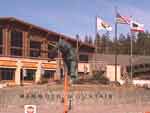 |
The AASI Rider Rally is a snowboard event
modeled after the PSIA National Academy. Although it's a Rocky
Mountain division event, it's open to all AASI members and is good for credit
in any division! The 2002 event was held April 17-21 at Mammoth
Mountain, California. If you missed this event, don't read this article. It will
be, like, way too depressing dude. |
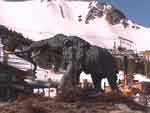 |
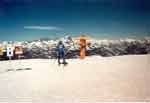
|
Early to mid April conditions are always a
crap shoot. Corn snow and slush are usually the norm. Sure enough, early arrivals
were treated to Eastern like "bullet proof" snow combined with high
winds. Since riding the steeps was extremely risky, my two days prior to the
event were spent performing very loud skids while I played with different stance
angles on the bottom half of the mountain. Fortunately, 8 inches of fresh dropped the night before the event started
and by
some miracle actually stuck to most of the mountain despite the 40-70 mph winds.
Although a couple runs were blown down to bare ice, a few had knee deep
snow and mid winter conditions prevailed through the rest of the week.. With all of the "freshies" available, the planned clinic schedule went
right out the window. The first two days most of the attendees chose
"explore the mountain" clinics which turned out to be mostly
"have fun in the powder" days. |
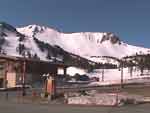 |
 |
On day 1, I went out with Earl Saline (AASI
demo team member from Steven's Pass, Wa.). While most of the group ripped
through the powder as fast as we could, Earl made sure to assist the slower
members who were not used to riding knee deep. While we were catching our
breath between runs, we did manage to discuss stance and technique adjustments for
powder riding (e.g.. move the bindings back a bit, adopt a wider stance, focus
on a nose up move at turn completion). I was trying out the "duck"
stance and Earl quickly commented about my narrow stance (I had only moved the
front binding back in order to get back to a should width stance). He made some
recommendations to other group members as well. The general theme for the day
was: flatter board angle, less motion across the hill and a smooth flow through
the turn (no jerky movements). On steeper terrain, Earl cautioned that always
looking straight down the hill would cause muscle fatigue and to look more in
the direction of the turn instead. We finished the day with a back flip
exhibition off a wind lip. Earl took the pressure off by demonstrating
Whitetail's signature trick (the
vertical 180) into a pillow of soft snow. |
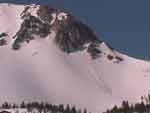 |
 |
Day 2 brought a couple more inches of fresh.
Our group leader was Ady Millican, the Mammoth Mountain Snowboard Director.
Ady had a "homer's" advantage for giving us a tour of the mountain,
but Mammoth was still too big to hit it all one day. Although we ran into some
windblown and some sketch on our tour, Ady knew where to go to find the good
stuff. Ady followed Earl's approach
of talking tech only when asked, but also keeping an eye out for the slower
folks. Ady's advice centered mostly on which lines to take, but he also
provided lots of positive feedback when he spotted folks making good moves. The
coyote cruising up the trail over at the Eagle section wasn't quite as
talkative, but was almost as inspirational as Ady. |
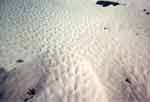 |
|
Day 3 was an off day. Some went riding in the
fresh dusting of light snow that fell all day. Half the group did the hour drive
down to Bishop to golf. Although we did see some flakes while on the course
(ahem - snow flakes), the weather was comfortably cool for golf. True to
snowboarder tradition, there were some that needed the day off for hangover
recovery time. |
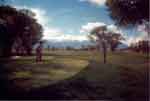 |
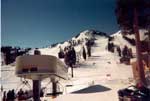 |
On Day 4, I took advantage of the Volkl demo
boards that rally organizer Eric Sheckleton brought along. My first demo board
was a 2003 model fresh out of the plastic and it was "schweeet". As
conditions were creeping back to packed powder, a carving clinic was in order.
Steve Craig (Big Sky SB super) was our clinic leader. He had a full day planned
for us and he did not disappoint. We started with a focus on vertical body
movement to help build a 90 degree angle between the femur and the lower leg
using a series of pine cone drills. At first, we just rode switching the cone
from our front hand on toe side turns to our back hand on heel side turns. then
we moved the cone behind the front leg (at knee level) on toe side and on top of
the back knee on heel side. Steve suggested we could keep moving the cone lower
to as low as touching the feet, but the Saturday "crowds" provided a
good excuse for not going quite that low. [ Eastern riders take note: Mammoth's
mid April post dump Saturday crowds meant the lift line was a long as four
chairs, once or twice. ] We left the pine cones at the base so that we could
focus on pressure points. Steve asked us to focus solely on the ball of the back
foot on toes side turns and the forward part of the back of the front foot
contact with the high back on heel side turns. This was interesting for me
because the toe side focus was natural, but the heel side focus point was a new
experience. This was setting me up for a big improvement later in the day. Eric
caught up with us to do some video. We watched this apres riding so we would not
miss any of our bluebird day on the snow.
|
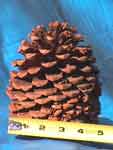 |
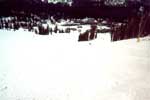 |
After lunch, we moved on to the bamboo drills.
While using bamboo might be a safety issue at some crowded resorts, this was not
a problem at Mammoth. Steve also reviewed the safety issue of carrying bamboo on
the lifts (he suggested the clinic leader carry all of the boo) and the
possibility of injury while riding and carrying boo during the exercises. We
started by just carrying the boo with an overhand grip on the front hand and an
underhand grip in back. Then Steve asked us to check on fore/aft tilt of the
pole throughout the turn. The best part was when we did the outrigger moves. The
idea was to drag the end of the bamboo in the snow. On a heel side, we dragged
the back of the boo behind the back foot on the toe side of the board. For toe
side turns, we dragged the boo even or just ahead of the front foot on the heel
side of the board. This seemed really weird, but I started ripping my carves
right away. The last boo exercise was to keep the boo level to the pitch of the
slope throughout the turn. If you finish your turns going uphill, this means you
need to be tipping the boo from right to left versus just front down to level as
you cross the slope. Although this exercise makes you think about a lot of extra
stuff, it can help identify a lot of problems like jerky movements in the turn
and the old "park and ride" syndrome. |
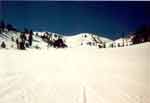 |
|
The last drill of the day was to perform a
cross under movement in large radius turns. I always wondered how to do this and
some of the group were thoroughly confused. The idea is to extend your legs in
the finish part of the turn and flex your legs (suck up the feet) at turn
initiation. Although it seemed backwards, it worked for me. The bottom line is
that it is a just a different way to ride. I think it will do wonders in the
bumps. |
|
|
On Saturday night everyone car pooled down to
Bishop for bowling and pizza (sponsored by the Rally). The highlight of the
evening was the after dinner raffle. Most of the prizes were hats, shirts,
gloves, etc. The fun part was that anyone who won a later prize could force a
trade with someone who won an earlier prize. Some of the trades were hilarious,
some were practical. Almost everyone won something. I won a brand new Palmer
board (which thankfully was exempt from the forced trade rule). |
|
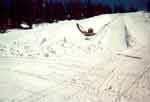
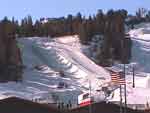 |
On Sunday, we gave up waiting for the super
pipe to get finished. The groomers had been working on it all week, adding about
5 feet to each wall to get ready for a competition in May, but they still
weren't done. So we did our pipe clinic in the small pipe with the 10 foot
walls. Ian Kirk, from Winter Park, was our clinic leader. We started with a warm up
run on the corduroy. The task was to do slow turn initiation with a relatively
flat board, then aggressively angle the board at turn completion to accelerate
across our imaginary pipe that was about 3 cats wide. The idea was to accelerate
into the wall, ride up, turn and ride down with a flat board, then accelerate
into the next wall on edge. Next we added a "pump" move when going up
the wall by throwing our hands up and having our body follow. The trick was to
do this move without messing up the body movement from vertical to horizontal as
the board goes from horizontal to vertical. With all this extra speed, Ian gave
us a safety move: just exit the pipe if you're uncomfortable. Although I was
thinking "Yeah, right - easier said then done", I soon found myself
sitting on the wall going "oh ... d'uh" as I'd just done the move
without even thinking about it. The last tip was to take angles into the walls
to minimize the amount of rotation needed to get down the wall. Ian took
advantage of different wall textures to clearly demonstrate take off and landing
points. Since knowing what to do is only half of pipe riding, the group started
spreading out doing "laps" on the high speed chair. Some folks from
the other groups tried hiking the pipe, but the chair was just as fast and far
less tiring. We started coaching each other on head and shoulder movements to
initiate turns, getting the pump movement right and just general cheerleading. |
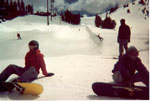 |
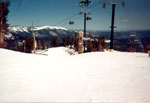 |
Above the pipe was Mammoth's huge terrain
park. There's a sign in the park noting a long list of Olympians who hold
Mammoth season passes. The park had a great mix of monster hits and tame hits.
Some of the tame hits were side by side with bigger ones to provide good
opportunities for transitions from small to big that minimized height off the
ground. The park had a great flow with plenty of room between hits. The park
also had at least 6 different rails in their park, including a curved rail, a
stair step rail and a vertical box with a rail top that was over 20 feet off the
ground at the downhill end. Since Rusty was trying out another demo board, he
conveniently used that as an excuse to not ride the rails. Then after a few runs
through the park, I decided to work on my carving on a parallel trail while on
my way to the pipe. On the ride up I got to watch some of our group members
going off the big monster. 20 feet off the ground and 60-80 feet in the
air meant that it was "you name it, they'll jump it" time. Not that this old fart is chicken or anything, but I did end
the day taking one of our group members to the hospital with a broken shoulder.
Ah youth! "
Poor" Mike lost all sympathy when I spotted the pair of Amazons who came to pick
him up. |
 |
|
All in all, the 2002 Rider Rally was a
monstrously fun event that was well run at a fantastic mountain with great
conditions and great people. As a plus, we also learned a lot too. With a good
mix of certification levels and a good age and geographic mix we all had a lot
to share and got as much as we gave. I hope this article has inspired some of
you to sign up for next year's Rally or at least given you some ideas you can
steal for own riding and teaching. |
|